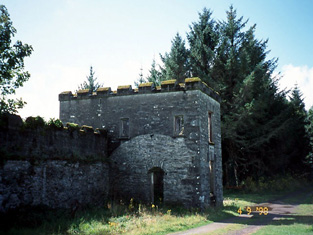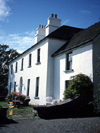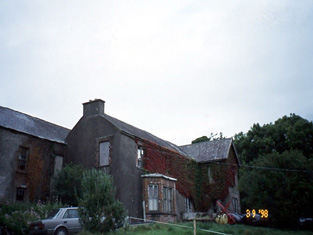Clodragh or Derriana Lodge
Houses within 15km of this house
Displaying 17 houses.
Houses within 15km of Clodragh or Derriana Lodge
Displaying 17 houses.
| House name | Description | |
|---|---|---|
| Derryquin Castle | At the time of Griffith’s Valuation James F. Bland was leasing a property valued at £29 at Derryquin, from the Guinness estate. Lewis, in 1837, and Leet, in 1814, record the house as the seat of Francis C. Bland . The property was eventually sold by the Blands to the Warden family. In 1906 it was owned by Col. Charles W. Warden and valued at £70. The Wardens resided there until it was burnt in 1922. It was located in the grounds of what is now the Parknasilla Hotel but the ruins were demolished in 1969. See www.parknasillahotel.ie for e-book on the history of this property. |

|
| Hollywood | Frederick Hyde was leasing a house valued at almost £10 from the Bland estate at the time of Griffith’s Valuation. Lewis records Hollywood as the seat of the Hyde family in 1837. Frederick Hyde was married to Elizabeth Bland. Bary states that the house was built in the 1830s, possibly on the site of an older house. It was occupied by the Bland family after they sold Derryquin but later fell into disrepair and is now a ruin. | |
| Parknasilla | James F. Bland was leasing a house valued at £10 to Christopher Bland at the time of Griffith’s Valuation. Bary states that some historians believe this to be the original Bland house in the area. In the mid 19th century it became known as the Bishop’s House as it was leased by the Bland estate to Bishop Graves of Limerick. Later still it became the forerunner of the Parknasilla hotel, in which grounds it is still located. A second house in the townland is labelled Clashnacree House [V721649] on the 25-inch Ordnance Survey map of the 1890s. In 1894 Slater records this latter house as the seat of J.F. Fuller. It is still extant. | |
| West Cove | Edward J. Hartopp was leasing this property at Coad, valued at £14 15s, to Eugene O’Sullivan at the time of Griffith’s Valuation. Lewis mentions Castle Cove as the residence of Mr. O'Sullivan in 1837 but he may have meant this house. In 1814, Leet noted Cooe as the seat of John Sesggerson and Bary states that, prior to the O'Sullivan occupation, West Cove was the seat of the Seggerson family. It is still extant and sometimes let as holiday accommodation. |

|
| Drimna House | James F. Bland was leasing a house valued at £7 to Rev. Arthur Watson at the time of Griffith’s Valuation. In 1906 Col. Charles W. Warden owned a property at Drimnamore, valued at £3 10s. It is still extant. | |
| Scart | James F. Bland was leasing a house valued at £10 15s to William Jermyn at the time of Griffith’s Valuation. Bary states that Scart house was occupied for several generations of the Jermyn family before being sold in the 1890s. It is still extant and occupied. |

|
| Castle Cove | Thomas Jermyn was leasing a house valued at £10 10s to John Jermyn at the time of Griffith’s Valuation. Lewis describes Castle Cove as the seat of Mr. O'Sullivan in 1837 though he may have been referring to West Cove House. Leet, in 1814, mentions "Cooe Castle" as the seat of David Jermyn, Bary notes that Castle Cove was in the possession of the Jermyn family in the nineteenth century. They were agents for the Bland estate. It is no longer extant. | |
| Liss Cottage | James F. Bland was leasing a house valued at £5 to David Jermyn at the time of Griffith’s Valuation. This appears to be Liss Cottage, which Bary states was a residence of the Jermyn family for a long time. There is still a house at this site though it may have been altered. | |
| Coomlumminy Court | The representatives of Reverend D. Mahony were occupying a house valued at almost £5, together with over 1400 acres at the time of Griffith’s Valuation. In 1906 this was the property of Mary Mahony and valued at £3. The building was labelled Coomlumminy Court on the 1st and subsequent edition Ordnance Suvey maps and is now a ruin. | |
| Srugreana Abbey | Daniel McCarthy was occupying Srugreana Abbey at the time of Griffith's Valuation, when it was valued at £9. In 1894 Slater notes it as the seat of Samuel T. McCarthy. In the 1940s the Irish Tourist Association Survey described it as "a large modern residence" fornerly that of the late Samuel T. McCarthy, a judge in India and later editor of the Kerry Archaeological Magazine. Bary indicates that this property was held by descendents of the McCarthy Mor family, owners of this area before the seventeenth century confiscations, who continued as tenants of the Lansdowne estate. The property was sold in the 1930s and demolished later in the twentieth century. | |
| Carhan House | Maurice O'Connell held several properties at Carhan Lower, at the time of Griffith's Valuation, including a mill, valued at £18, which he was leasing to Patrick Trant. In the 1830s, the Ordnance Survey Name Books record that the mills had been built by Messers Trant and Barry c.1828. There were two other houses, one valued at £18, leased to James Barry, MD, and the second, valued at £6, leased to Rev. John Healy. Carhan House is named on the 1st edition OS map as "in ruins". Lewis notes "Cashen" as the old mansion of the O'Connell family in 1837. In the 1830s, the Ordnance Survey Name Books describe Carhan House as "a rectangular building, having a kitchen built up to the rere, all two stories high. The walls of its ruins are standing but in a state of dilapidation". The Irish Tourist Association Survey in 1943 described the original house as "in the shape of the letter T with the kitchen apartments nearest the river". In 1814 Leet refers to one property in Carhan as the residence of James O'Connell and to a second as the address of Miles McSweeney. |

|
| Hillgrove | Lewis refers to Hillgrove as the residence of J. Primrose in 1837.In the 1830s, the Ordnance Survey Field Name Books described it as " a rectangular building with two wings, all two stories high and in good repair". Bary states that Hillgrove House was built by John Primrose, senior, agent to the O'Connell estate, in the early nineteenth century. It was being leased by John Primrose, (possibly son of the earlier John) to Denis Coughlan, at the time of Griffith's Valuation, when it was valued at £19 5s.The property was offered for sale in July 1854 in the Encumbered Estates Court when David O'Connor is recorded as the tenant at Hillgrove. Primrose was also a principal lessor in the parish of Caher at this time. Hillgrove is now demolished and much modern development has taken place in the area. | |
| Waterville | Caleb Chute was leasing a property valued at £18 to James Butler at the time of Griffith's Valuation. Both Lewis, in 1837, and Leet in 1814, noted Waterville as the residence of James Butler .The Ordnance Survey Name Books described it as " two stories high and in good repair" in 1840. Bary indicates that the house was built by the Butler family in the late eighteenth century and they resided there until 1965. It is now a luxury guesthouse with a golf links nearby. |

|
| Kineigh | Thomas Stoughton was leasing this property, valued at £10 15s, to John Fitzgerald at the time of Griffith's Valuation. In 1840, the Ordnance Survey Field Name Books indicated that it was the residence of Rev. George Hickson but had been built by John Hayes at the end of the eighteenth century. It seems to have become a Fitzgerald property later on. In 1894 Slater referred to it as the seat of John Francis Fitzgerald. The Fitzgerald family continued to reside there until the 1930s. The house is still extant. Adjacent to Kineigh House a site labelled "Donnall O'Sulivan's House (site of)" appears on both the 1st and 25-inch edition Ordnance Survey maps. |

|
| Emlaghmore House | Thomas Smith was leasing this property from the Lansdowne estate at the time of Griffith's Valuation, when it was valued at £12 10s. Bary states that this house was associated with a branch of the O'Connell family, one of whom, Mary, married Daniel O'Connell. It later fell into ruin and nothing remains today. | |
| Fermoyle Castle (Iveragh) | Charles Sugrue was in possession of this property at the time of Griffith's Valuation, when it was valued at £15. In 1906 it was owned by the representatives of Edward Sugrue. Bary states that there was originally an O'Sullivan castle at this site, on to which a house was built by John Sugrue in the 1820s. The Sugrue family later moved to Cork and the house was used for some years as the local Catholic presbytery. It is now a ruin. | |
| Bahaghs Lodge | At the time of Griffith's Valuation, a property here appears to have been leased from Charles O'Connell to the Cahersiveen Board of Guardians for use as an auxiliary workhouse. Bahaghs Lodge is labelled as "in ruins" on the 1st edition Ordnance Survey map but is shown as "Bahaghs Lodge" on the later 25-inch Ordnance Survey map. Bary notes that Charles O'Connell is said to have built it in 1833 around the time of his marriage to Katherine O'Connell, daughter of the Liberator. The family were later obliged to leave the property due to financial difficulties. Portions of the ruin now remains. |

|

